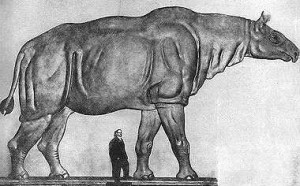Updated on: 05/04/2022
Paraceratherium is an extinct genus of hornless rhinoceros that lived during the Oligocene epoch (around 34–23 million years ago). They were one of the largest land mammals that have ever roamed on earth. Paraceratherium coexisted with other animals, such as weasels, hyaenodonts, nimravids, cats, rhinoceroses, artiodactyls, rodents and bear-dogs.
| Kingdom: | Animalia |
| Phylum: | Chordata |
| Class: | Mammalia |
| Order: | Perissodactyla |
| Family: | Hyracodontidae |
| Subfamily: | Indricotheriinae |
| Genus: | Paraceratherium |
| Species: | Paraceratherium bugtiense (the type species)Paraceratherium transouralicumParaceratherium prohoroviParaceratherium orgosensis |
| Other Names: | Indricotherium and Baluchitherium |
| Name meaning: | “near the hornless beast” |
| Weight: | 33000 to 44000 pounds |
| Size: | Shoulder height – 16 feetLength – 24.3 feetSkull length – 4.3 feet long |
P. transouralicum is the most completely known species of this genus. If the classification of P. bugtiense and P. transouralicum derives because of sexual dimorphism, then it would make them same species. A fraction of scientists considers P. orgosensis as a distinct genus.

Earlier, paleontologists believed that genus Paraceratherium, Indricotherium and Baluchitherium were different, but later research, principally by JC Sobus and SG Lucas, in 1989, revealed that they are same. The name Paraceratherium was introduced in 1911; while the name Indricotherium was introduced in 1915. Most paleontologists prefer to go with the old name.
Fossil remains of Paraceratherium have been found in Oligocene formations of Eurasia, such as modern-day China, India, Pakistan, Mongolia, Kazakhstan, Turkey, Romania, Georgia, Bulgaria as well as the former Yugoslavia. Scientists believe that their existence is correlated with the Alpine-Himalayan mountain range’s palaeogeographic development.
Paraceratherium species inhabited varied ranges across its native range, such as arid desert basin (in Mongolia), woody shrubland (in China) and temperate to subtropical forests in some of its ranges.
Their lifestyle was similar to elephants. Scientists believe that they dwelt in small herds, probably consisting of females and calves. It is believed that they mate in every two years and gave birth to one calf. Males often get into a fight during the mating season.
They were browsers, and their diet primarily consisted of soft leaves. They also consumed twigs, shrubs and barks. They had a long digestive tract.
Bite marks found on the bones collected from Bugti beds suggest that they were preyed upon by large crocodiles, Crocodylus bugtiensis.
The reasons for its extinction are not known. However, there are several hypotheses that go around, such as low reproduction rate and climate change. Another theory adds that large predators like Amphicyon and Hyaenaelurus entered Asia during the early Miocene and preyed upon Paraceratherium calves and other herbivores.